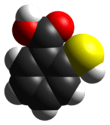Thiosalicylic acid
Thiosalicylic acid is an organosulfur compound containing carboxyl and sulfhydryl functional groups. Its molecular formula is C6H4(SH)(CO2H). it is a yellow solid that is slightly soluble in water, ethanol and diethyl ether, and alkanes, but more soluble in DMSO.[3]
| |||
| Names | |||
|---|---|---|---|
| Preferred IUPAC name
2-Sulfanylbenzoic acid[1] | |||
| Other names
2-Mercaptobenzoic acid o-Thiosalicylic acid ortho-Thiosalicylic acid | |||
| Identifiers | |||
3D model (JSmol) |
|||
| 508507 | |||
| ChEBI | |||
| ChEMBL | |||
| ChemSpider | |||
| ECHA InfoCard | 100.005.187 | ||
| EC Number |
| ||
| 3838 | |||
| KEGG | |||
| MeSH | 2-Thiosalicylic+acid | ||
PubChem CID |
|||
| RTECS number |
| ||
| UNII | |||
CompTox Dashboard (EPA) |
|||
| |||
| |||
| Properties | |||
| C7H6O2S | |||
| Molar mass | 154.18 g·mol−1 | ||
| Appearance | Leaf or needle shaped crystals | ||
| Density | 1.49 g cm−3[2] | ||
| Melting point | 162 to 169 °C (324 to 336 °F; 435 to 442 K) | ||
| log P | 2.39 | ||
| Acidity (pKa) | 3.501 | ||
| Hazards | |||
EU classification (DSD) (outdated) |
|||
| R-phrases (outdated) | R36/37/38 | ||
| S-phrases (outdated) | S26 | ||
| Related compounds | |||
Related compounds |
Salicylic acid | ||
Except where otherwise noted, data are given for materials in their standard state (at 25 °C [77 °F], 100 kPa). | |||
| Infobox references | |||
Preparation and uses
Thiosalicylic acid can be prepared from anthranilic acid via diazotization followed by the addition of sodium sulfide and then reduction with zinc.[4]
Thiosalicylic acid is a precursor to the dyestuff thioindigo. Thiosalicylic acid is also used to make the vaccine preservative thiomersal.
Other aspects
It is a precursor to drug candidates for treatment of atherosclerosis and melanoma.[5][6]
References
- "Front Matter". Nomenclature of Organic Chemistry : IUPAC Recommendations and Preferred Names 2013 (Blue Book). Cambridge: The Royal Society of Chemistry. 2014. p. 697. doi:10.1039/9781849733069-FP001. ISBN 978-0-85404-182-4.
The prefixes ‘mercapto’ (–SH), and ‘hydroseleno’ or selenyl (–SeH), etc. are no longer recommended.
- "A13401 Thiosalicylic acid, 98%". Alfa Aesar. Retrieved 2010-08-10.
- Lide, David R., ed. (2009). CRC Handbook of Chemistry and Physics (90th ed.). Boca Raton, Florida: CRC Press. p. 3-324. ISBN 978-1-4200-9084-0.
- C. F. H. Allen and D. D. MacKay (1943). "Thiosalicylic acid". Organic Syntheses.; Collective Volume, 2, p. 580
- Smalley, Keiran S.M; Tim G. Eisen (1 April 2002). "Farnesyl thiosalicylic acid inhibits the growth of melanoma cells through a combination of cytostatic and pro-apoptotic effects". International Journal of Cancer. 98 (4): 514–522. doi:10.1002/ijc.10213. PMID 11920610.
- George, Jacob; Arnon Afek; Pnina Keren; Itzhak Herz; Iris Goldberg; Roni Haklai; Yoel Kloog; Gad Keren (2002). "Functional Inhibition of Ras by S-trans,trans-Farnesyl Thiosalicylic Acid Attenuates Atherosclerosis in Apolipoprotein E Knockout Mice". Circulation. 105 (20): 2416–2422. doi:10.1161/01.CIR.0000016065.90068.96.
This article is issued from Wikipedia. The text is licensed under Creative Commons - Attribution - Sharealike. Additional terms may apply for the media files.

